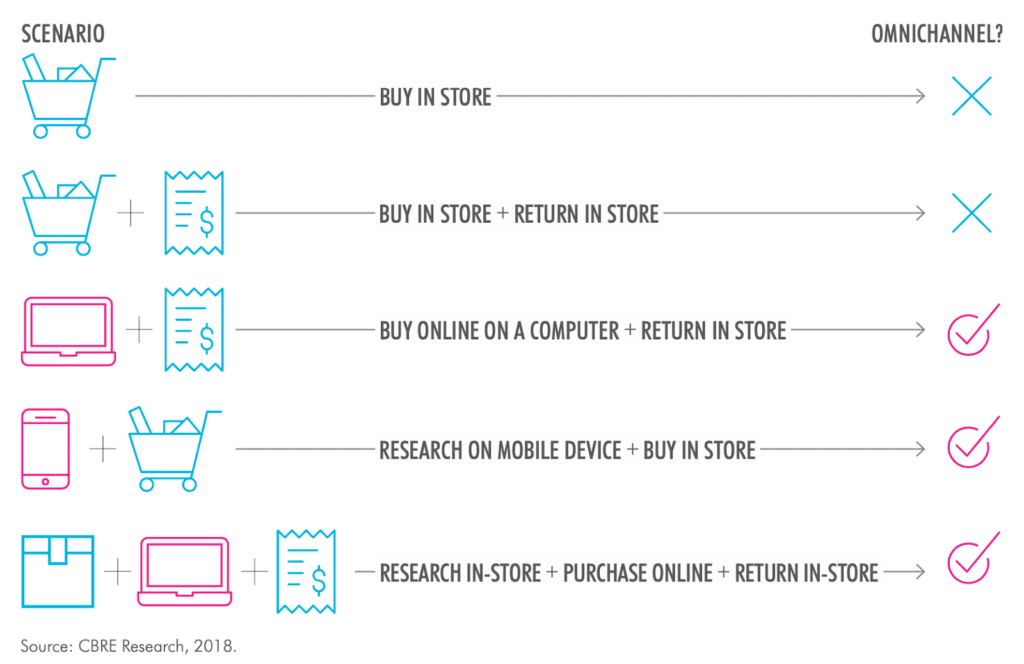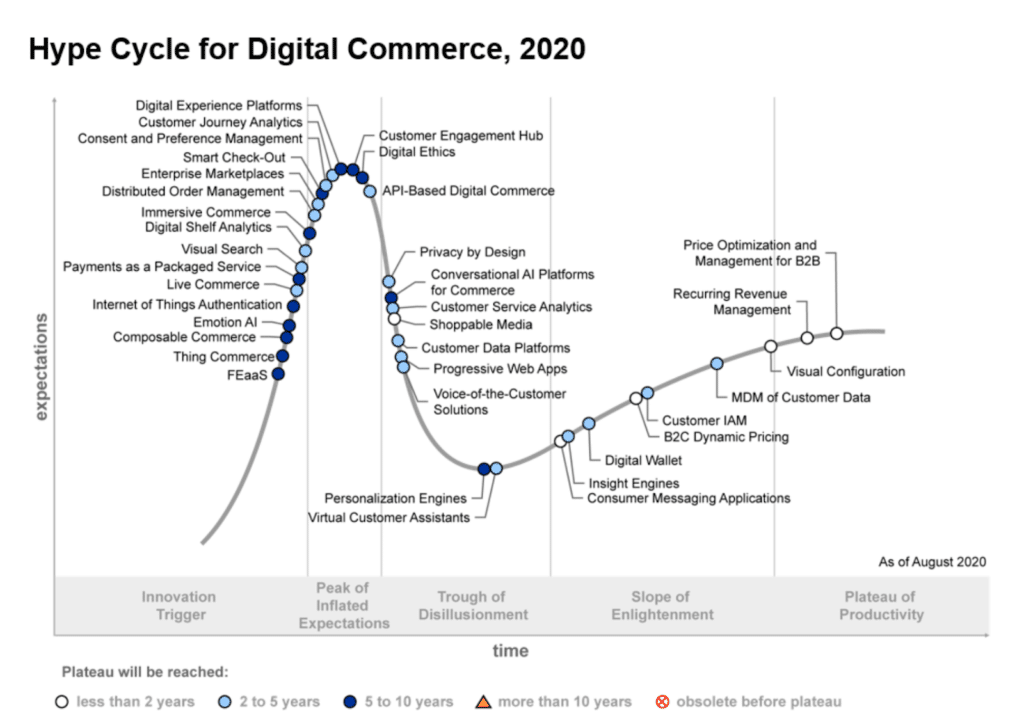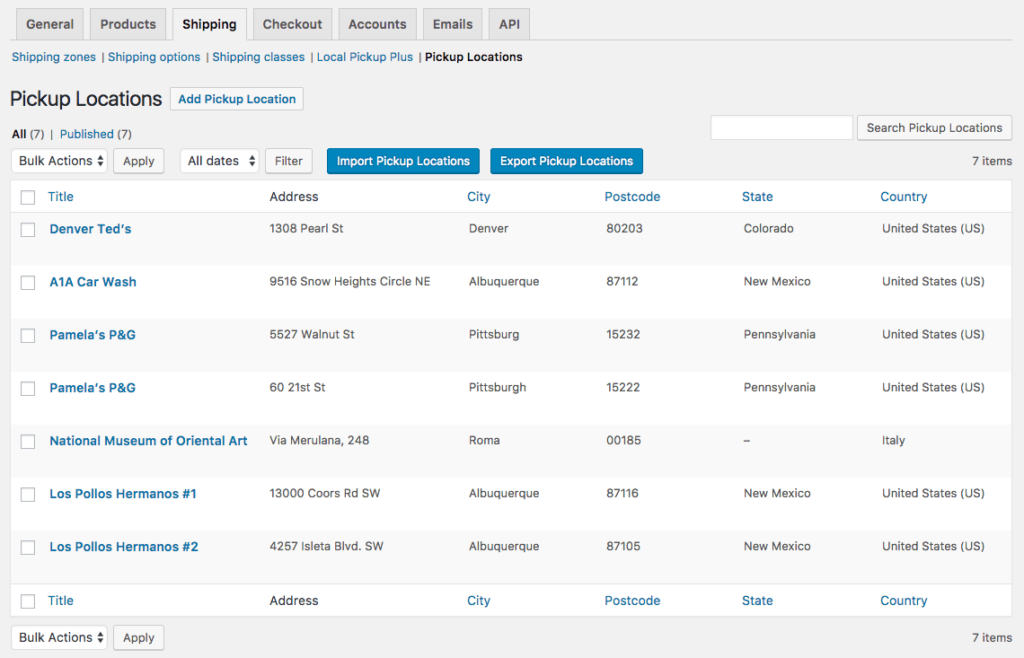
Understanding eCommerce Trends: Omnichannel Commerce
The world we live in continues to change rapidly. Younger generations have become a guiding force for the adoption of new technologies, and their expectations for digital experiences are constantly moving the needle of “what’s next” in the way all of us interact online.
With that said, it’s important for businesses to stay ahead of the curve and understand the trends of tomorrow to thrive in a competitive landscape.
Although the concept of Omnichannel Commerce is often defined as a “trend,” it’s here to stay—at least, for the foreseeable future. As shopping behavior evolves, there’s a need for businesses to innovate and adapt to new challenges. Omnichannel offers a clear path for accomplishing both.

Especially during the Covid-19 pandemic, digital commerce has become a major focus. To survive in a rapidly changing market, brick-and-mortar businesses have had to adapt quickly, build an online presence, and expand their eCommerce capabilities to retain customer loyalty.
In this article, we’ll cover the digital commerce strategies that are growing in adoption, focusing on Omnichannel Commerce specifically. What’s the goal? Increasing revenue, driving more traffic to stores, and improving the bottom line is always the business goal. But the higher purpose is ultimately creating a better shopping experience for your customers.
Every customer interaction counts. So it’s important to respond to their needs with a strategic approach that offers the best experience possible to the customers that support your business.
In this first installment of a three-part series on eCommerce trends, we’ll cover the following sections:
- What is Omnichannel Commerce?
- Does Omnichannel Commerce work?
- What are the benefits of Omnichannel Commerce?
- Omnichannel Commerce with WordPress
- Connecting your in-store and online experiences.
What is Omnichannel Commerce?

According to BloomReach,
“Omnichannel commerce is a multichannel approach to sales that focuses on providing a seamless customer experience whether the client is shopping online from a mobile device, a laptop, or in a brick-and-mortar store.”
Of course, every market leader has their own definition of Omnichannel but the strategy is consistent: offer a cohesive customer experience across the online and physical worlds.
This concept might be confused with Multichannel Commerce. In contrast, Multichannel Commerce offers independent channels where customers can purchase products. These digital channels typically function in silos, disconnected from one another.
For example, let’s say you have a website that functions as an eCommerce store, however, it’s not the only place you sell your products. Through another channel, you also sell your products on Amazon and have established your brand presence within the confines of that platform.
Additionally, you might be leveraging social media platforms such as Instagram and Facebook to sell products and increase customer engagement. While each channel may have positive results on its own, these channels don’t talk to each other, and you have to manage inventory, sales + marketing strategy, and metrics separately for each platform.
While Multichannel involves independent channels where you may sell your products, an Omnichannel approach is focused on capturing the entire customer experience across your brand for a more seamless experience shopping online.

Instead of having the customer engage the same way in multiple siloed channels, Omnichannel takes it a step further by bridging these siloed experiences and integrating the segmented parts into a unified whole. In other words, this approach provides an integrated shopping experience no matter where the customer goes.
It’s worth mentioning that Omnichannel is a strategy that builds on Multichannel Commerce by connecting all the dots laid out in the Multichannel approach. Without Multichannel, Omnichannel doesn’t exist.
These channels are not limited to platforms that sell your product. Different channels (sales and marketing) include an online store, brick-and-mortar store, social media platforms, mobile apps, email, and text messaging to name a few.
There are also touchpoints that blend physical and digital elements, such as interactive kiosks, tablets, and even smart shelf technologies. In the Omnichannel approach, all of these channels mesh together to provide the customer with an immersive experience-with the customer as the core focus. If anything, Omnichannel retailing is an approach focused on designing a cohesive human experience.

Does Omnichannel Commerce work?
Is there truly a need for an Omnichannel Commerce strategy? The short answer is, it depends on your business objectives.
If you’re the owner of a small business that only serves the local community, a single-channel strategy could work perfectly fine. That might look like an online store powered by WooCommerce or an online marketplace like Etsy.
However, if you’re a struggling retail business invested in digital transformation, it’s worth building your digital commerce presence and providing a more integrated experience for your customers.
According to a study of 46,000 shoppers conducted by the Harvard Business Review:
- The Omnichannel strategy differentiates retailers from their peers and gives them a competitive edge over online-only retailers by leveraging their store assets.
- Of the study participants, 73% of shoppers used multiple channels during their shopping journey. Only 7% were online-only and 20% were store-only shoppers.
- Customers who conducted online research on an Omnichannel retailer’s site or other sites before shopping led to 13% greater in-store spending.
This is only one study among many that confidently says Omnichannel shoppers are more valuable to retailers than single-channel shoppers. Whether you’re a traditional retailer or purely an online store, leveraging Omnichannel strategies can provide a better experience for your shoppers and ultimately, improve revenue.
What are the benefits of Omnichannel?

Seamless customer experience.
The old mantra, “serve your customers where they are,” remains true. Today, customers interact with businesses and their brands through a wide array of touchpoints—digital and otherwise.
From researching products on your blog to social shopping on Instagram, an Omnichannel approach allows businesses to stay connected and aligned with the customer throughout each stage of the shopping journey (research, test, decide, purchase, obtain, or other iterations of the AIDA model).
In a fully functional Omnichannel model, each stage of the journey could take place, across different channels, both online and offline.
Based on a (2017) study by Forrester Research, the percentage of offline sales that are digitally influenced will steadily increase.

A more up-to-date Forrester Research study predicts this to grow to 58% by 2023.
To illustrate this growing trend, we can observe how shoppers may want to make a purchase. Let’s say a customer is interested in purchasing a backpack. The first thing this shopper may do is use their phone to research the product on the brand’s website.
After that initial research, the customer uses a laptop to investigate the best price across different platforms. They discover the business sells the same backpack on different marketplaces including Amazon.
Although Amazon is selling the product at a lower price , this particular shopper needs the backpack immediately, for travel the next day, and can’t afford to wait for shipping. So, they make the purchase directly through the business’s online store and then visit the physical store to pick up the backpack.
That’s just one example of how the digital experience can influence a customer’s buying decision.
Many businesses that embrace an Omnichannel approach offer customers the convenience of visiting a brick-and-mortar store to pick up a product they just purchased online.

In addition to adding to an overall seamless customer experience, these customers are advantageously exposed to more products in-store, which often leads to more sales. By allowing customers to “window shop” and purchase products using their channels of preference, businesses can make the shopping experience between offline and online worlds even smoother.
On the backend, your business can also offer more delivery options beyond the traditional delivery service or in-store pickup. Offering more options for delivery and returns can help remove customer friction points, again, adding to a seamless customer experience.
Returns are particularly important to this part of the equation. According to a 2019 UPS study:
73% of online shoppers say that the returns experience affects their likelihood to buy again from a retailer.
In fact, given the choice of shipping a return or returning to a store after an online purchase, 39% of U.S. and 42% of Canadian respondents prefer to return items directly to a store. Why? It’s faster, more convenient, and it’s free. There are also fewer concerns around delays in refunds.
By dissolving the walls between channels, customers can interact with your brand not only more seamlessly but also in a way that feels most natural.
Boost sales and traffic.

Referring back to the Harvard Business Review study, the more channels customers use, the more valuable they are to a business.
Based on the results:
“Customers who used 4+ channels spent 9% more in the store, on average, when compared to those who used just one channel.”
For Omnichannel shoppers, doing research online leads to more in-store spending. Furthermore, these shoppers are also more loyal and likely to make more purchases over time.
Within six months after an Omnichannel shopping experience, these customers had logged 23% more repeat shopping trips to the retailer’s stores and were more likely to recommend the brand to family and friends than those who used a single channel.
A study conducted by Business Insider also confirms this trend. The more customers interact with a business through different channels, the more likely they are to purchase products.

As the research shows, an Omnichannel experience can be a powerful strategy to transcend traditional retail and lift revenue dramatically.
Better data & metrics.

As customers interact with a brand on multiple channels, the data those channels collect typically lives in silos too. For one, each channel has a specific, niche purpose for collecting data that doesn’t always translate to other systems. In other words, they don’t talk nicely to each other.
As an example, how do you leverage the data from a customer who interacts with your online store, Facebook page, and mobile app? This can be challenging without the proper technologies.
Since each channel collects its own customer data, it can become time consuming and difficult to connect the dots to truly understand customer behavior across multiple touchpoints. This is where an Omnichannel approach can lead to better analytics, more effective campaigns and targeting, and ultimately, improved conversions.
Once you have visibility into how customers interact throughout all channels holistically, you’ll have more contextual data to make informed decisions and better engage your customers. How? By offering more personalized experiences at the right place and the right time.

Of course, it’s not that straightforward or easy to accomplish this goal. In order to offer personalized experiences across different platforms, businesses need tools that can unify siloed data and offer a 360 view of the entire customer journey.
There are many different ways to offer personalized experiences to customers. As a foundation, a Digital Experience Platform (DXP) acts as the central platform where your business can control and connect multiple digital touchpoints and integrations. Essentially, DXPs function as the command center to manage, deliver, and optimize digital experiences across the entire customer journey.
In regards to data specifically, one technology that’s growing in hype, as well as adoption, is the Customer Data Platform (CDPs). The CDP Institute defines a CDP as a packaged software that creates a persistent, unified customer database accessible to other systems.
Basically, CDPs collect data across multiple channels which are often siloed into a singular, comprehensive view. By capturing this data, you can build a unified profile around each customer as they interact with your business across multiple channels. As this data becomes more structured, it can be leveraged through your other marketing tools to optimize customer interactions.
Additionally, one of the pillars of CDPs is leveraging Artificial Intelligence (AI) and Machine Learning (ML) to unearth deeper customer insights and more effective campaign suggestions. As the dataset grows, the platform gets smarter.
According to Gartner, customer data and analytics is a growing trend that will reach mainstream adoption in the next two to five years. These technologies include personalization engines, customer journey analytics, Voice-of-the-Customer (VoC), CDP, Master of Data Management (MDM), and customer service analytics.

In terms of the bottom line, leveraging data more effectively allows your marketing spend to achieve higher ROI. However, better data can not only improve sales, it also empowers businesses to serve customers better.
With these evolving technologies, there’s an opportunity to optimize each and every valuable interaction with a customer. And ultimately, to deliver more compelling customer experiences.
Omnichannel Commerce with WordPress.

Is your business ready to embark on the Omnichannel journey? As an open source digital platform, one of the biggest strengths of WordPress is its ability to integrate readily with best-in-class technologies.
By far, the most popular WordPress eCommerce solution is WooCommerce, which makes up 30% of the entire eCommerce market. As with WordPress, one of the key strengths of WooCommerce is its customizability and broad array of extensions.
For business owners who are learning how to set up WooCommerce, already have a WooCommerce store, or are planning to build one, here are some ways to enhance the customer experience and integrate the different channels your shoppers interact with.

Natively, WooCommerce offers the option for customers to pick up purchased products in-store through Local Pickup. However, this particular feature is limited to stores with only one physical location.
For retailers with multiple locations, distribution centers, or pickup sites, Local Pickup Plus offers more robust features and granular control. These settings include displaying a list of available pickup locations for each product, hiding locations that are out-of-stock, and allowing scheduled pickups.

Initially, Square launched to allow local merchants a way to accept credit card payments in-person. Since then, the platform has evolved into a robust suite of business tools for sellers of all sizes.
Now, the platform offers an integration with WooCommerce so you can accept Square payments online, sync the product library and inventory between both systems, and manage sales within a centralized dashboard.
If you’re looking to integrate both the online and offline experience more seamlessly, consider using Square as part of your digital commerce tech stack.
3. Third Party Plugins
In addition to the officially supported plugins by Woo, there are a variety of integrations that can help businesses achieve their Omnichannel goals.
Although options are not limited to this list, here are a few tools that integrate well with WordPress:
- Plug-and-play retail operations system: skuIQ
- Inventory management and shipping platform: Veeqo
- Omnichannel marketing automation: Omnisend
It’s worth noting that taking on an Omnichannel approach is not limited to plugins. With an open source platform like WordPress, the extensibility expands to integrations that support customer APIs.
Connecting your in-store and online experiences.
So, how do you actually connect the physical store with the online store? There are several critical components you’ll need to consider.
Assuming you’ve chosen an eCommerce platform that supports omnichannel, you’ll need to choose a Point-of-Sales (POS) system that does as well. Once these two systems are integrated, the POS system can collect online and offline data including product libraries, sales information, and inventory—all in one cohesive place.
Specifically, a cloud-based POS system would prevent the need to store data physically on hardware which can lead to several challenges including scalability. Square’s POS product is a good example of an omnichannel, cloud-based solution.
At its core, the basic functionality of a POS system looks like this:

To expand on the example of an Omnichannel POS system, imagine going into your favorite clothing store, and the sales reps can guide you through the shopping experience with a POS integration on an iPad. They can show you variations of products not available in-store, look up inventory online, and create a shortlist of clothing items you’d like to try on.
To offer a consistent contextualized experience online, this data can be stored in your account for future recommendations or personalized chat support.
When you’re ready to purchase a product, the sales rep can process the payment through the POS system and collect your email address in-store. That way, you can keep track of digital receipts, access brief surveys, and stay up-to-date with upcoming promotions.
Additionally, the email address can be associated with your payment data and bridge the gap between in-store and online interactions.
If you are selling products across multiple channels, then a Product Information Management (PIM) system can connect the dots. A PIM acts as a single place to collect, manage and update your product information— preventing inconsistencies across multiple channels. As a business scales in the global market, a PIM system becomes even more important to centralize product data.
Whether these are emerging technologies or custom-built services, businesses are taking advantage of the speed-to-market, lower entry cost, and flexibility of an open source platform —without being locked into proprietary, closed architecture. The possibilities are truly endless.
Stay tuned for part two in this three-part series: Understanding eCommerce Trends: Headless Commerce.
Power your digital commerce with WP Engine

Optimize your Omnichannel strategy on the managed WordPress hosting platform of choice. Find out more about WP Engine’s WooCommerce hosting solution or speak to a specialist and get started today!


Start the conversation.